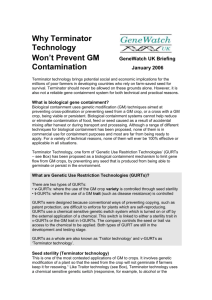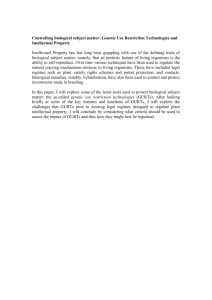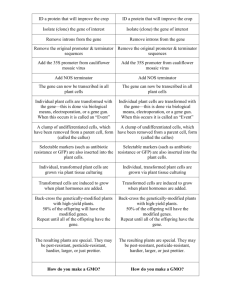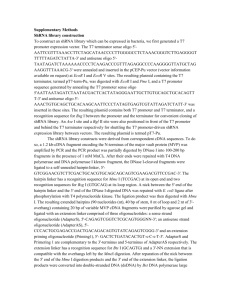Renewed calls to ban `Terminator Technology`
advertisement
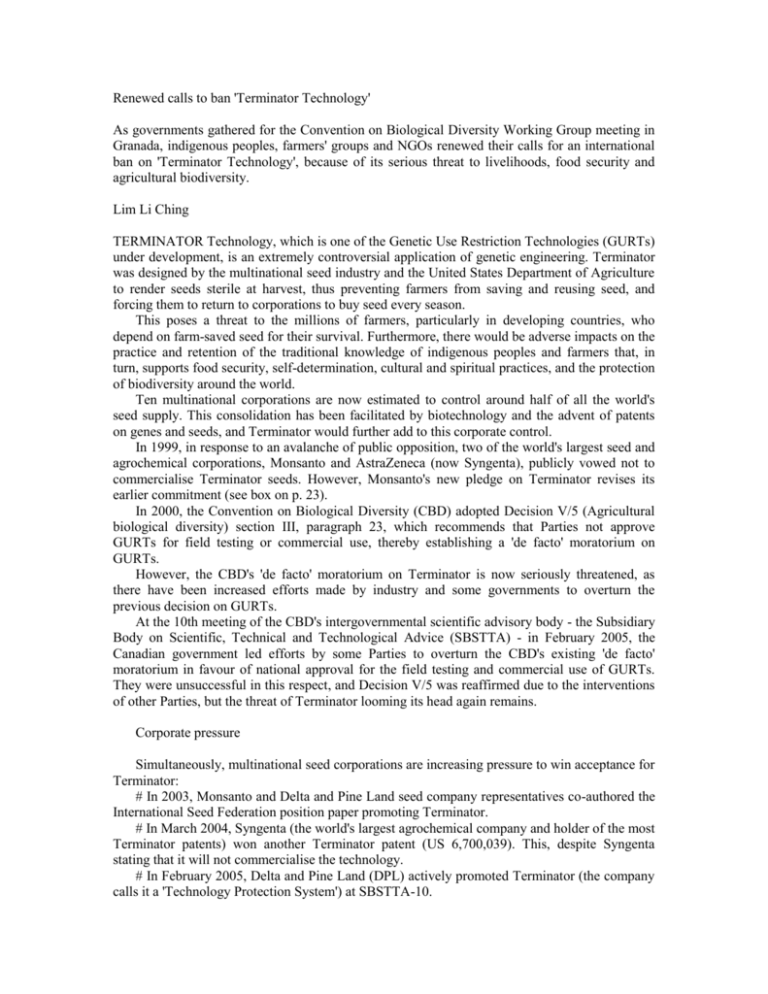
Renewed calls to ban 'Terminator Technology' As governments gathered for the Convention on Biological Diversity Working Group meeting in Granada, indigenous peoples, farmers' groups and NGOs renewed their calls for an international ban on 'Terminator Technology', because of its serious threat to livelihoods, food security and agricultural biodiversity. Lim Li Ching TERMINATOR Technology, which is one of the Genetic Use Restriction Technologies (GURTs) under development, is an extremely controversial application of genetic engineering. Terminator was designed by the multinational seed industry and the United States Department of Agriculture to render seeds sterile at harvest, thus preventing farmers from saving and reusing seed, and forcing them to return to corporations to buy seed every season. This poses a threat to the millions of farmers, particularly in developing countries, who depend on farm-saved seed for their survival. Furthermore, there would be adverse impacts on the practice and retention of the traditional knowledge of indigenous peoples and farmers that, in turn, supports food security, self-determination, cultural and spiritual practices, and the protection of biodiversity around the world. Ten multinational corporations are now estimated to control around half of all the world's seed supply. This consolidation has been facilitated by biotechnology and the advent of patents on genes and seeds, and Terminator would further add to this corporate control. In 1999, in response to an avalanche of public opposition, two of the world's largest seed and agrochemical corporations, Monsanto and AstraZeneca (now Syngenta), publicly vowed not to commercialise Terminator seeds. However, Monsanto's new pledge on Terminator revises its earlier commitment (see box on p. 23). In 2000, the Convention on Biological Diversity (CBD) adopted Decision V/5 (Agricultural biological diversity) section III, paragraph 23, which recommends that Parties not approve GURTs for field testing or commercial use, thereby establishing a 'de facto' moratorium on GURTs. However, the CBD's 'de facto' moratorium on Terminator is now seriously threatened, as there have been increased efforts made by industry and some governments to overturn the previous decision on GURTs. At the 10th meeting of the CBD's intergovernmental scientific advisory body - the Subsidiary Body on Scientific, Technical and Technological Advice (SBSTTA) - in February 2005, the Canadian government led efforts by some Parties to overturn the CBD's existing 'de facto' moratorium in favour of national approval for the field testing and commercial use of GURTs. They were unsuccessful in this respect, and Decision V/5 was reaffirmed due to the interventions of other Parties, but the threat of Terminator looming its head again remains. Corporate pressure Simultaneously, multinational seed corporations are increasing pressure to win acceptance for Terminator: # In 2003, Monsanto and Delta and Pine Land seed company representatives co-authored the International Seed Federation position paper promoting Terminator. # In March 2004, Syngenta (the world's largest agrochemical company and holder of the most Terminator patents) won another Terminator patent (US 6,700,039). This, despite Syngenta stating that it will not commercialise the technology. # In February 2005, Delta and Pine Land (DPL) actively promoted Terminator (the company calls it a 'Technology Protection System') at SBSTTA-10. # On 5 October 2005, DPL and the US Department of Agriculture won a new patent on Terminator from the European Patent Office (EP 775212B). # On 11 October 2005, DPL and the US Department of Agriculture were awarded a Canadian patent on Terminator (CA 2196410). In addition, corporations like Delta and Pine Land, the company behind Terminator, are now presenting Terminator as 'enhancing biosafety and biodiversity'. This company and many others, including Monsanto and Syngenta, were damaged by the initial international protest against their plans in the late 1990s. Having been pressed by public opinion to make statements that they would not develop Terminator crops, they now seem to be seeking a more acceptable image for their intentions. To allay fears about contamination from genetically engineered crops, they are now presenting the technology as suitable for 'biological containment', to prevent gene flow, which is one of the recognised threats of genetically engineered crops. Unreliable However, Terminator is not a reliable gene containment system for both technical and practical reasons. It is not a biosafety tool and cannot be 100% effective. Conversely, Terminator crops, like other genetically engineered crops, may pose threats to the environment and human health. In the first place, biological containment systems cannot help reduce or eliminate contamination of food, feed or seed with genetically engineered genes that is a result of accidental mixing after harvest or during transport and processing. Terminator is also a complex and largely experimental system that has several shortcomings in terms of gene containment. Terminator crops will still produce pollen and could cross with neighbouring non-genetically engineered or organic crops. So, gene flow could still occur, with potentially catastrophic impacts on agrobiodiversity and biodiversity, and on seed-saving. Furthermore, because the system relies on a chemical-sensitive genetic switch to ultimately activate a toxin gene that prevents seed germination, the chemical would need to be applied to the seed before it is sold. However, the treatment of seeds may not be completely effective. The effect may be sufficient to make saving seed an unreliable exercise for farmers, but not enough for complete gene containment. The chemical-sensitive genetic switch may also be activated by some of the plant's own chemicals or may not be completely switched off all the time. This 'leakage' could lead to fertile seeds being produced, and thus the failure of Terminator to prevent gene flow. Other problems, such as gene silencing or instability of one component, could lead to failure of the whole system. Gene silencing is one phenomenon seen in genetically engineered crops that arises from the introduction of foreign genes. Furthermore, the genes forming the Terminator system have to be linked together to work properly, so if they split during reproduction, the system would fail. The industry's spin recasting Terminator as effective in preventing genetic contamination and gene flow from genetically engineered crops is seriously flawed. In fact, Terminator's only real value is to benefit corporations economically, by forcing farmers to buy seed every season. 'Hot potato' issue The efforts to overturn the CBD's 'de facto' moratorium on Terminator continued at the meeting of the Working Group on Article 8(j) of the CBD in Granada on 23-27 January (see next article for an account of what happened at the meeting), which was asked 'to consider the potential socio-economic impacts of genetic use restriction technologies (GURTs) on indigenous and local communities'. The 8(j) Working Group was established by the CBD to specifically address the implementation of Article 8(j) and related provisions of the Convention. Article 8(j) deals with issues related to the knowledge, innovations and practices of indigenous and local communities relevant for the conservation and sustainable use of biological diversity. The Working Group was tasked to make recommendations on the potential socio-economic impacts of GURTs to the eighth meeting of the CBD's Conference of the Parties (COP8), to be held in Curitiba, Brazil from 20-31 March 2006. Terminator had already proven to be a 'hot potato' issue, passing among various CBD bodies, starting from when the Ad Hoc Technical Expert Group (AHTEG) on Genetic Use Restriction Technologies met in February 2003 to consider the potential impacts of GURTs on smallholder farmers, indigenous and local communities. Its report was critical of Terminator and noted the potential negative socio-economic and cultural impacts. In fact, in addition to reaffirming Decision V/5 III, the AHTEG report recommended that Parties and other governments 'consider the development of regulatory frameworks not to approve GURTs for field-testing and commercial use'. However, the AHTEG report has been criticised by some Parties (who are unhappy with the overall tone of the report which is critical of Terminator) for not representing a consensus viewpoint and for not being 'scientific'. The AHTEG report was sent to SBSTTA-9, as well as the third meeting of the 8(j) Working Group for consideration and advice in 2003. At the third meeting of the 8(j) Working Group, held in December 2003, a draft recommendation was drawn up on GURTs. However, some representatives considered that there had been insufficient time to adequately address the issue, which they argued required further indepth assessment and discussion. The Working Group thus recommended that its next meeting (i. e. the meeting in Granada) be the forum to consider the potential socio-economic impacts of GURTs on indigenous and local communities. Meanwhile, SBSTTA-9 avoided the controversial issue by claiming that it was unable to provide advice because of the broad agenda before it, and proceeded to transmit the AHTEG report to the Conference of the Parties (COP7) while recommending that COP7 request SBSTTA10 to provide advice on GURTs to COP8. In February 2004, COP7 in turn urged the 8(j) Working Group to consider the potential socio-economic impacts of GURTs on indigenous and local communities. When SBSTTA-10 met in February 2005, it could not reach consensus on the AHTEG report. Civil-society campaign This is the crossroads at which the world stands now on Terminator, following a long, tortuous route and repeated delays in seriously addressing the issue. The 8(j) Working Group meeting in Granada was in a unique position to make strong and conclusive recommendations to COP8. Unfortunately, this was not the case (see next article). Civil society groups have thus stepped up their efforts to ensure that Terminator is banned once and for all, and formed the Ban Terminator Campaign (www.banterminator.org) in 2005. The Campaign is supported by groups and movements across the world including AS-PTA (Assessoria e Servicos a Projectos em Agricultura Alternativa), ETC Group (Action Group on Erosion, Technology and Concentration), GRAIN, Indigenous Peoples Council on Biocolonialism, ITDG (Intermediate Technology Development Group), Pesticide Action Network Asia and the Pacific, Third World Network and Via Campesina. To date, over 300 organisations have declared their support for a global ban on Terminator Technology. Lim Li Ching is a researcher with Third World Network based in Malaysia. BOXED ARTICLE Monsanto's change of tune on Terminator IN response to worldwide opposition, Monsanto, the world's largest seed and agbiotech company, made a public promise in 1999 not to commercialise Terminator Technology. Then-CEO, Robert Shapiro, wrote an open letter to the Rockefeller Foundation stating, 'I am writing to let you know that we are making a public commitment not to commercialise sterile seed technologies, such as the one dubbed "Terminator".' Now, a revised pledge from Monsanto suggests that it would use Terminator seeds in nonfood crops and does not rule out other uses of Terminator in the future. In its 2005 Pledge Report, Monsanto has revised its commitment, pledging to keep Terminator only out of food crops opening the door to the use of Terminator in non-food crops such as cotton, tobacco, trees and grass. Referring to new versions of GURTs, Monsanto's 'pledge' now says, 'Monsanto does not rule out the potential development and use of one of these technologies in the future. The company will continue to study the risks and benefits of this technology on a case-by-case basis.'

